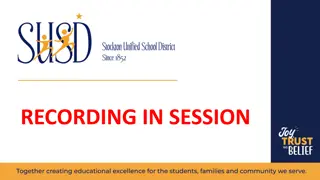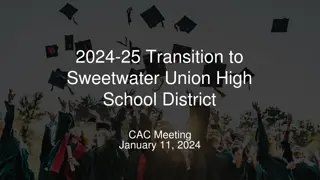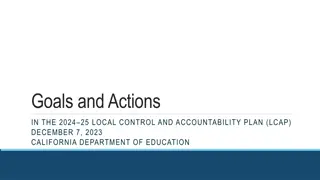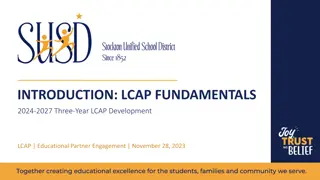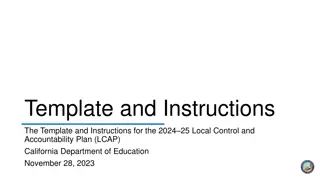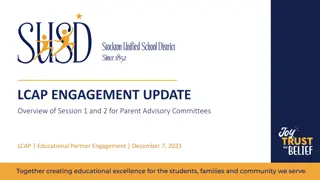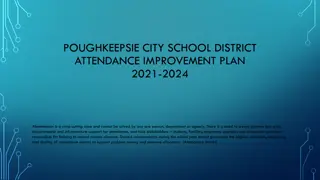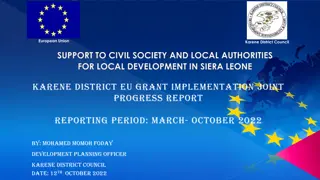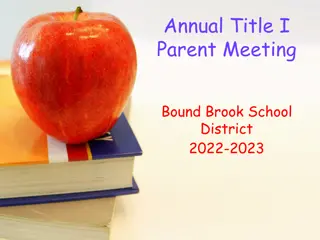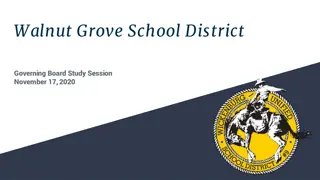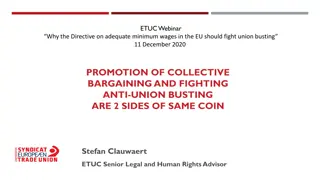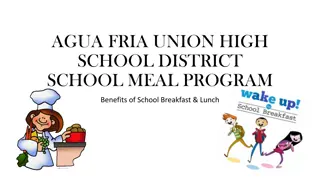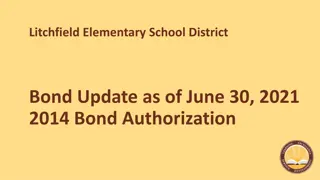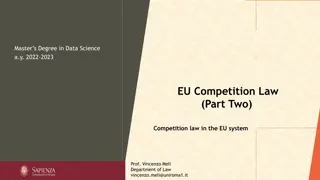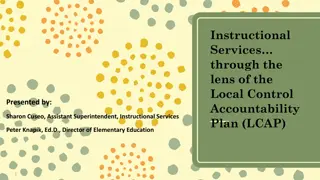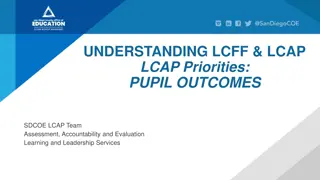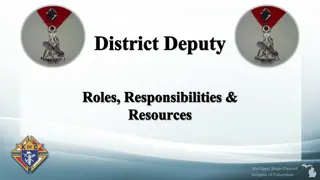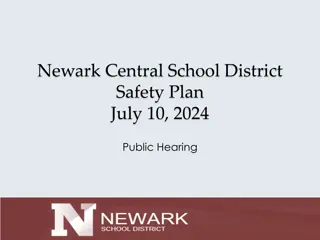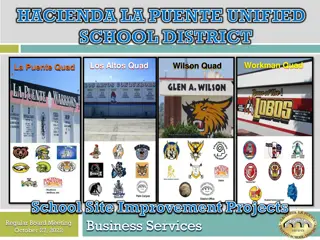Berryessa Union School District LCAP Annual Update Presentation
The presentation covers the Local Control Funding Formula (LCFF) overview, funding details for the school district, information on the Local Control Accountability Plan (LCAP), and the annual update timeline. It highlights how the district engages stakeholders in developing yearly LCAPs to support student achievement based on state and local priorities.
Download Presentation

Please find below an Image/Link to download the presentation.
The content on the website is provided AS IS for your information and personal use only. It may not be sold, licensed, or shared on other websites without obtaining consent from the author.If you encounter any issues during the download, it is possible that the publisher has removed the file from their server.
You are allowed to download the files provided on this website for personal or commercial use, subject to the condition that they are used lawfully. All files are the property of their respective owners.
The content on the website is provided AS IS for your information and personal use only. It may not be sold, licensed, or shared on other websites without obtaining consent from the author.
E N D
Presentation Transcript
NAME THAT EMOTION You will call out your emotion that you are currently feeling and choose the emoji that best characterize that emotion. Please explain why you are feeling that particular emotion. Each of you will have the space to express yourself.
THE STORM The Question: You are a meteorologist, and you see one of the first tropical storms of the season form in the Caribbean. What are you going to be looking for over the next few days, and how will that impact what action you take? Item 1: http://toolboxforteachers.s3.amazonaws.com/Core/PBL-Nuggets/Hurricane/Hurricane-tracking- map.pdf Item 2: https://www.screencast.com/t/bs9w3aF0JHCq Item 3: http://toolboxforteachers.s3.amazonaws.com/Core/PBL-Nuggets/Hurricane/Hurricane-safety- checklist.pdf
ELEMENTARY CHOICEBOARD ELA Social Studies To adapt is to make fit or modify. Choosing the right word to accurately fit or describe something involves understanding figurative language. Go on a figurative language hunt for the senses in your home. Find items that you feel represent each of the five senses: touch, sight, taste, smell, sound. Take a picture of each item and create figurative language labels to describe them. Include similes, metaphors, hyperbole, personification and onomatopoeia in your labels. Create a minimum of two labels for each item. For example, you might find a fuzzy sweater and put Sense of Touch at the top and under the photo write, soft as a kitten (simile) and a warm hug for the body (metaphor). Adaptation takes time. Take a picture of your phone, computer or television, the vehicle you ride in daily or the food in your fridge or pantry. Now, working backwards in time, research the "relatives" of the past for the item you chose. Create a timeline to show the item's history. Questions to consider: How have the technological advances in communication, transportation and agriculture impacted our world both positively and negatively? What impact have they had on people regardless of geographic locations? Take it a step further, and predict how you think technological advances in communication, transportation and agriculture will continue to be adapted in the future. Science Mindfulness Humans and animals have to adapt to their environments. How have you adapted over the past year? How did COVID-19 change your/your family s behavior? What behaviors did you notice that changed in our society? Discuss with your family what adaptations you've made over time. Are there any you think you/ society will keep even after things are "normal"? Create a COVID-19 Behavior time capsule. Write down your observations and answers to these questions on small strips of paper. Put the papers in the box or jar, label it (so you don t forget what it is) and store it away to be opened in 5 years, then again in 10 years. It will be interesting to see what life is like in the future and remember the changes in the past. Write the word YET, with your non-dominant hand and your eyes closed. Open your eyes and look at what you wrote. Reflect on how it looks and whether it looks like how it's "supposed" to look. A fixed mindset is the belief that there is one right way to do things and that our abilities are fixed and cannot change. Now adapt or change the drawing into something else entirely (ex. - a picture, a different word, abstract art, etc.). How did you adapt your yet ? How did adapting your yet impact how you felt about the task and about your yet creation? This flexible, adaptive thinking is a characteristic of growth mindset; it focuses on effort and flexible thinking.
MIDDLE SCHOOL CHOICEBOARD ELA Social Studies Select a book to read that also has a film adaptation. After reading the book, watch the film. How are the movie and book similar? How is the movie different from the book? Take note of the creative choices that were made by the director or screenwriter. Keep the following in mind: Analyze why these choices may have been made. How might the budget have impacted these creative choices? How was the film adapted to make the story move more quickly? Were scenes simply removed or were important parts of the plotline changed? How did the decisions that were made impact the story? Send an email to the movie s screenwriter and/or the book s author to share your observations and ask for insight into the adaptation process Throughout history humans have made adaptations to weapons to meet their ever changing needs. Watch this video about the history of weapons: https://youtu.be/chWOqVqQTa0 Choose three of the weapons to research in more detail. Consider the following questions: What weapons were used prior to the development of each weapon? How did the weapon change warfare? Did the weapon change society? If so, how? Has war adapted because of the weapon? Explain. Is the weapon still used today? If so, how? If not, why not? What are your thoughts on adapting weapons for modern warfare Create a presentation to share your findings. Science Mindfulness Some diseases are linked to environmental factors. In some cases, lifestyle choices, such as a choice to use tobacco products are what create these environmental factors. In these cases, individuals can make adaptations to their lifestyles in order to prevent or reduce the likelihood of developing the disease. Check out the National Institute of Environmental Health s document about environmental diseases: https://www.niehs.nih.gov/health/assets/docs_a_e/environmental_diseases_environm ental_diseases_from_a_to_z_english_508.pdf As you read about the diseases, create a chart with a column listing each disease, possible factors leading to it, and then a third column with suggestions for prevention. Consider if there are any lifestyle choices you can make changes as to while you are young which will help you stay healthy for a long time. During the Covid-19 pandemic, many of us had to adapt to a new learning environment. What are some things you had to change due to remote learning? Spend at least three minutes brainstorming the ways remote learning was different from learning at school. Be sure to include benefits as well as drawbacks. Read the article to see how different students adapted to remote learning: https://www.edutopia.org/article/why-are-some-kids-thriving-during-remote-learning What can we learn from the experience? Write a letter to your school board members suggesting changes to how schools teach based on what you have learned.
SOURCES https://pblhelpforyou.weebly.com/pbl-mini-lessons.html https://www.dpi.nc.gov/students-families/enhanced-opportunities/advanced-learning-and-gifted- education/2020-aig-remote-learning-resources https://www.edutopia.org/project-based-learning-guide-activities


